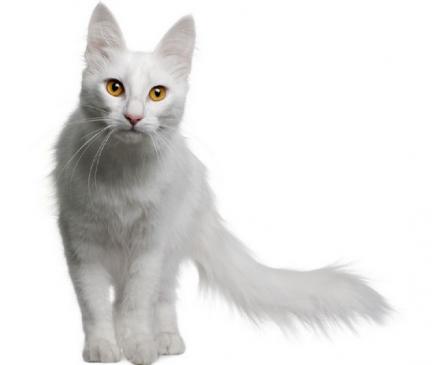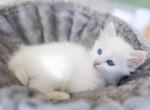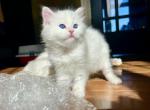

Turkish Angora Cat Breed Description
Turkish Angora Traits At A Glance
Active
Playful
Requires Attention
Affectionate
Vocal
Docile
Intelligent
Independent
Health
Grooming
Child Friendly
Pet Friendly
Size: The Turkish Angora is medium in size and weighs 5 to 10 pounds on average.
Characteristics: While the Turkish Angora is known for having an all white coat, they actually come in quite a few colors and patterns and the variations are growing in popularity. Beneath their lovely long and silky coat is a medium size, svelte body. They are quite graceful and have long, slim legs and a long coat. Their head is the shape of a long, pointed wedge and some do have jowls. They have large, almond-shaped knowledgeable eyes accompanied by large, pointed ears that stand erect.
Temperament: The Turkish Angora is an affection and active cat. They love to be in the middle of everything and want to be wherever you are, at all times. They are athletic and agile and love to show off their abilities by climbing and leaping to great heights. They are intelligent and love to play jokes. And, when not playing jokes, they enjoy having a nice long chat with anyone willing to listen. They will actively engage your attention as much as they can and make their wills well known to all. And, don't be surprised if you find your Turkish Angora splashing around in the water, they are known to enjoy a good swim from time to time.
Care: The lovely, long and silky coat of the Turkish Angora does not mat easily or shed much, which makes it relatively easy to groom. Simply brush your Turkish Angora cat weekly to keep their beautiful coat looking nice. Occasional bathing may also be necessary to keep your cat in tip top shape. Trim their nails and clean their ears as needed. And lastly, it is important to brush their teeth frequently to prevent periodontal disease.
Coat: Turkish Angora cats are semi-longhaired and have beautiful and distinctive coats. Their coats are silky, soft, fine and have a lovely sheen. While white coats are what are traditionally seen, they come in a wide variety of colors and patterns and their coat is really their crowning glory.
Origin: The sweet looking Turkish Angora originated in the mountainous regions of Turkey. Though the exact story of how the Turkish Angora came to be is unknown, we do have a vague picture of their beginning. The Turkish Angora comes from Ankara (formerly Angora) and is actually the birthplace of many animals with long silky coats. As there is with many cat breeds, there are many tales and theories of how the Turkish Angora came to be. But, the most likely scenario is that the Turkish Angora is a descendant of the African wildcat. The long hair of the Turkish Angora is likely the result of a natural genetic mutation, but there are many early accounts of the cat.
There are written records of Turkish Angoras from 16th century France. Longhaired cats were quite popular and were imported to England frequently. The first Turkish Angoras made their way to Europe in the 1500s, by the 1600s they were commonly imported in Europe and by the 1700s were being imported to the United States. They quickly rose in popularity and became a very in-demand cat among fanciers. As the Persian began to grow in popularity, it began to overshadow the Turkish Angora. The Turkish Angora was used in Persian breeding programs to help improve the Persian coat according to preferences for longer and more silky looking coat. As Persians, Turkish Angora and Russian Longhairs were bred together more extensively the breeds became very confused and people struggled to tell them apart. The Turkish Angora ceased to exist as a separate breed.
Turkey considered the breed a national treasure and, in the early 1900s, began work to preserve the breed. An extensive breeding program began to work to maintain the beautiful look of the Turkish Angora, with white coats and blue eyes, gold eyes and odd eyes. The Turkish zoo was particularly interested in Turkish Angoras with odd colored eyes. The people of Turkey were very protective of their prized, beautiful cats and were reluctant to allow anyone to take the cats out of the country. Finally, in 1962, Colonel Walter Grant and his wife Liesa, who had been stationed in Turkey, were allowed to bring home two Turkish Angora cats to the United States. These two cats would go on to be the foundation of the breed in the United States.
Interest was quickly ignited among cat fanciers in the forgotten breed and Turkish Angoras rose quickly in popularity, yet again. Soon, a new breeding program was underway in the United States with more breeders taking on the task of importing Turkish Angoras. Once they were in the United States, it did not take long for them to be accepted by major associations. In 1968, White Turkish Angoras were officially recognized by the CFA and by 1972, the breed was granted championship status by the CFA. Later, in 1978, all colors of Turkish Angoras were accepted and all other major associations quickly recognized the breed as well. The breed, though still relatively small, enjoys a devoted following of cat fanciers.


